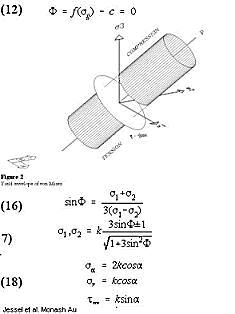
VON MISES CRITERION
Five independent slip systems are required for a grain to undergo an
arbitrary imposed deformation (this is called the von Mises criterion). The von Mises Yield criterion is the second invariant of the deviator
stress tensor and as such is mathematically rigorous and easy to handle.
It is also a good approximation for the physical models of polycrystalline
aggregates but rather a poor model for single crystals, where the yield
criterion is a function of the easy slip systems and anisotropy does not
cancel out. A polycrystalline material regains some of this anisotropy
after significant shear deformation, VON MISES SIMPLIFIED Neglecting very slow creep of lower than that of the upper mantle can be considered to be entirely elastic even on a geological time scale if it is loaded by a stress of less than that for low temperature plasticity. Simplifying one step further and neglecting the small elastic strain upon loading, low temperature plasticity can be modelled by the rheology of a rigid-plastic body. The rigid plastic rheology formalizes the concept of finite elastic strength in a very simple way. Strain in the elastic region is assumed to be negligible and for simplicity the elastic regions are treated as rigid bodies. The onset of plastic flow is governed by a yield criterion which defines a complete state of stress at which a point in a solid body is either elastic below, or plastic above, a limit stress. The theory of plasticity therefore formulates a dual constitutive material behaviour that can occur when a rock is loaded to a critical shear stress. This yield stress governed by all principle stresses is known as von Mises criterion.
|